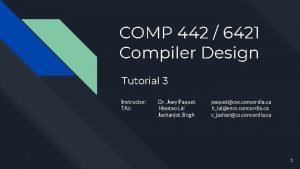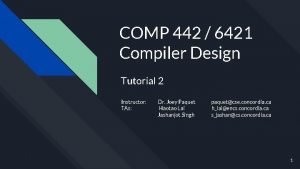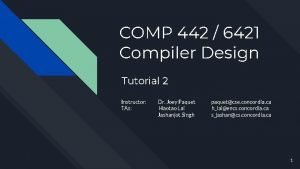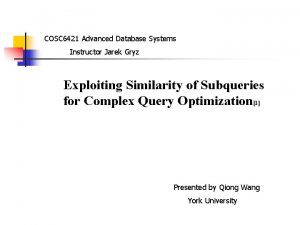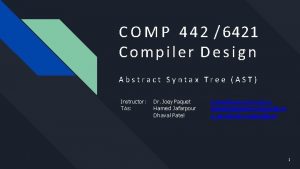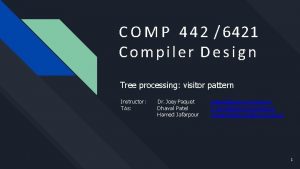C O M P 4 4 2 6421
























- Slides: 24

C O M P 4 4 2 / 6421 Compiler Design Code Generation I Instructor: TAs: Dr. Joey Paquet Hamed Jafarpour Dhaval Patel paquet@cse. concordia. ca hamed. jafarpour@concordia. ca p_haval@encs. concordia. ca 1

Outline - Tag-based approach in code generation Stack-based approach in code generation Offset Stack-based Function Call Mechanism Moon Processor Examples 2

Tag-based Approach in code generation In this approach: 1. For each variable you allocate a memory for it 2. Associatee it with a unique tag which is stored in the symbol table. 3. Accessing the variable (in-memory location) can be achieved by using the tag. Advantage: Simple Disadvantage: Cannot achieve all required functionalities 3

Stack-based Approach in code generation If accessing all the functionalities are needed, stack-based approach is needed. Advantage: Can achieve all requirement Disadvantage: Complicate 4

Offest Offset q It represent how far a variable away from a base address; q Regarding the implementation, the value of the offset can be positive or negative q For example, a member variable of a class, offset of the variable means how far this variable’s first address away from the first address of the class; In order to achieve code generation: Ø Add a new column, called offset, to your symbol table. Ø Calculate the offset of each data type when you add that entry into your table. 5

Offset Example 6

Stack-based Function Call Mechanism Stack Pointer Frame Pointer 7

Stack-based Function Call Mechanism Stack Pointer Frame pointer current function’s base address. Stack pointer where the new function frame should be put. 8

Stack-based Function Call Mechanism How you can know where you should put a, b, c and how to locate them? 9

Stack-based Function Call Mechanism How you can know where you should put a, b, c and how to locate them? Solution: Using Offset offset → the distance from the variable cell to the frame pointer (current function’s base address). stack pointer → where the new function frame should be put. 10

Stack-based Function Call Mechanism 11

MOON Processor - The M O O N processor is wrote by Dr. Peter Grogono in Concordia University. - It is a kind of “virtual machine” we used to run our generated code (assembly language) - You can get the source code of Moon in the bottom of the course website in the bellow link - https: //users. encs. concordia. ca/~paquet/wiki/index. php? title= COMP 442/6421_-_winter_2021 - You need very basic knowledge of assembly language 12

How to compile MOON? 1. 2. 3. 4. You need to have a C compiler (eg. gcc) Download the source code and unzip it Open Terminal, change your working directory to where you put the source code Compile it using the very basic compile command For example, if you are using gcc, just type the following command in the terminal: gcc [-o executable_file_name] moon. c Note: there is a PDF file accompanying with the source code, you are strongly suggested to read that file before you ask any question. 13

MOON Processor Important Parameters of MOON - All instructions of M O O N occupy one word - There are total 16 registers from R 0 to R 15, R 0 always contains zero - Program counter is 32 -bit and contains the address of next instruction to be executed - Memory address in the range of [0, 2^31], the usable memory is less than that 14

MOON Processor How to use MOON? There are 4 types of instruction: 1. Data access instructions 2. Arithmetic instructions 3. Input and output instructions 4. Control instructions Terminology - M 8[K]: it denotes the byte stored at address K; - M 32[K]: it denotes the word stored at address K, K + 1, K + 2 and K + 3; - An address is aligned if it is a multiple of 4; - An address is legal if the address byte exists; - The name PC denotes the program counter; - The name R 0, R 1, … denotes the registers; - The symbol ← denotes data transfer; Note: the slide cannot show all instructions provided by MOON, please consult the documentation for more detailed ! 15

MOON Processor Data Access Instructions Take load word as an example: R(i) ← 32 M 32[R(j) + K] means take one word data stored in the address ( R(j) + K ) and put it into register R(i) where K is: − 16384 ≤ K < 16384. 16

MOON Processor Arithmetic Instructions There are two types of arithmetic instructions: • Arithmetic Instructions with Register Operands • Arithmetic Instructions with an Immediate Operand 1. 2. Register Operands: R ( i ) ← R ( j ) + R ( k ), sum up the second and third register’s value and put the result into the first register; Immediate Operand: R ( i ) ← R ( j ) + k, sum up the second register’s value and the third value then put the result into the first register; 17

MOON Processor Arithmetic Instructions 18

MOON Processor Input and Output Instructions The instruction getc reads one byte from stdin, the standard input stream. Similarly, putc writes to stdout, the standard output stream 19

MOON Processor Control Instructions 20

Example of MOON As a first step for using MOON, we consider sample. m file which is the most simple example. 21

Example of MOON Sample. m Example 22

Example of MOON Sample. m Example 23

Thanks! 24
